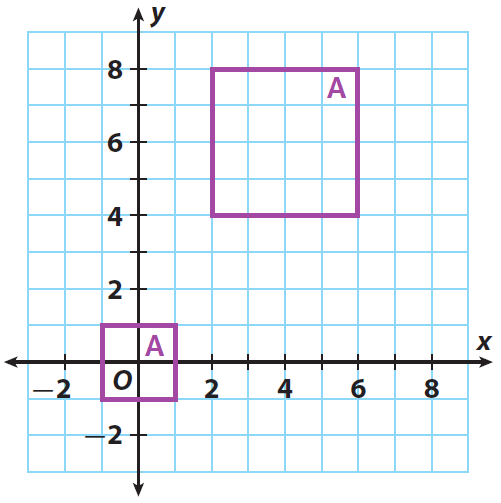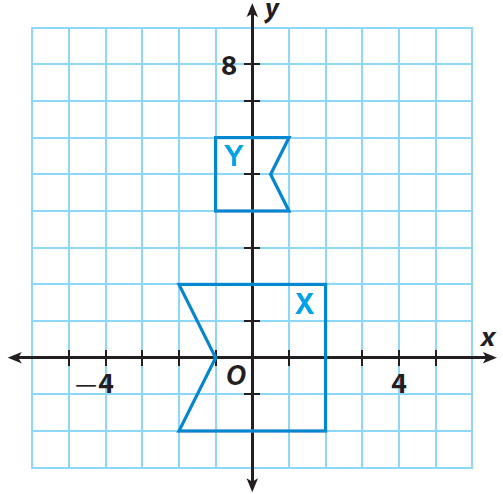SIMILAR FIGURES
Two figures are similar if one can be obtained from the other by a sequence of translations, reflections, rotations, and dilations. Similar figures have the same shape but they may have different sizes.
If two figures are similar, there must be a sequence of translations, reflections, rotations, and/or dilations that can transform one to the other.
Example 1 :
Identify a sequence of transformations that can transform figure A into figure B. Say whether the figures are congruent. And also, say whether they are similar.

Solution :
Step 1 :
Both figures are squares whose orientations are the same, so no reflection or rotation is needed.
Step 2 :
Figure B has sides twice as long as figure A, so a dilation with a scale factor of 2 is needed.
Step 3 :
Figure B is moved to the right and above figure A, so a translation is needed.
Step 4 :
A sequence of transformations that will accomplish this is a dilation by a scale factor of 2 centered at the origin followed by the translation
(x, y) ----> (x + 4, y + 6)
The figures are not congruent, but they are similar.
Example 2 :
Identify a sequence of transformations that can transform figure X into figure Y. Include a reflection. Say whether the figures are congruent. And also, say whether they are similar.

Solution :
Step 1 :
The orientation of figure Y is reversed from that of figure X, so a reflection over the y-axis is needed.
Step 2 :
Figure Y has sides that are half as long as figure X, so a dilation with a scale factor of 1/2 is needed.
Step 3 :
Figure B is moved to the right and above figure A, so a translation is needed.
Step 4 :
Figure Y is moved above figure X, so a translation is needed.
Step 5 :
A sequence of transformations that can accomplish this is a dilation by a scale factor of 1/2 centered at the origin, followed by the reflection
(x, y) ---> (-x , y)
followed by the translation
(x, y) ---> (x , y + 5)
The figures are not congruent, but they are similar.
Example 3 :
In example 2, identify a sequence of transformations that can transform figure X into figure Y. Include a rotation.
Solution :
Step 1 :
The orientation of figure Y is reversed from that of figure X, so a rotation of 180º is needed.
Step 2 :
Figure Y has sides that are half as long as figure X, so a dilation with a scale factor of 1/2 is needed.
Step 3 :
Figure Y is moved above figure X, so a translation is needed.
Step 4 :
Figure Y is moved above figure X, so a translation is needed.
Step 5 :
A sequence of transformations that can accomplish, this is a rotation of 180º about the origin, followed by a dilation by a scale factor of 1/2 centered at the origin, followed by the translation
(x, y) ---> (x , y + 5)
The figures are not congruent, but they are similar.
Kindly mail your feedback to v4formath@gmail.com
We always appreciate your feedback.
©All rights reserved. onlinemath4all.com
Recent Articles
-
Digital SAT Math Problems and Solutions (Part - 262)
Sep 09, 25 09:56 AM
Digital SAT Math Problems and Solutions (Part - 262) -
10 Hard SAT Math Questions (Part - 7)
Sep 09, 25 09:46 AM
10 Hard SAT Math Questions (Part - 7) -
10 Hard SAT Math Questions (Part - 6)
Sep 08, 25 08:58 PM
10 Hard SAT Math Questions (Part - 6)

